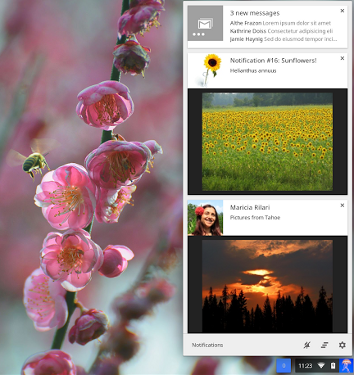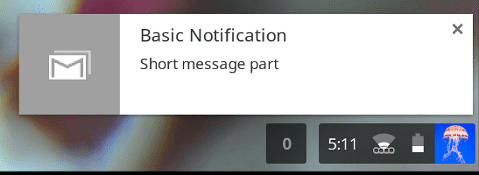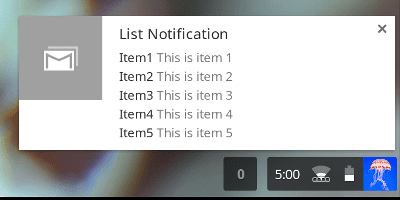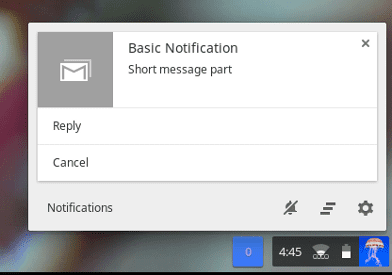The rich notifications API lets you create notifications using templates and show these notifications to users in the user's system tray:

How they look
Rich notifications come in four different flavors: basic, image, list, and progress. All notifications include a title, message, small icon displayed to the left of the notification message, and a contextMessage field, which is displayed as a 3rd text field in a lighter color font.
A basic image:

List notifications display any number of list items:

Image notifications include an image preview:

Progress notifications show a progress bar:

How they behave
On ChromeOS, notifications show up in a user's system tray, and stay in the system tray until the user dismisses them. The system tray keeps a count of all new notifications. Once a users sees the notifications in the system tray, the count is reset to zero.
Notifications can be assigned a priority between -2 to 2. Priorities < 0 are shown in the ChromeOS notification center, and produce an error on other platforms. Priority 0 is the default priority. Priorities > 0 are shown for increasing duration and more high priority notifications can be displayed in the system tray.
In addition to displaying information, all notification types can include up to two action items. When users click on an action item, your app can respond with the appropriate action. For example, when the user clicks on "Reply", the email app opens and the user can complete the reply:

How to develop them
To use this API, call the notifications.create method, passing in the notification details via
the options parameter:
chrome.notifications.create(id, options, creationCallback);
The notifications.NotificationOptions must include a notifications.TemplateType, which defines available notification details and how those details are displayed.
Create basic notification
All template types (basic, image, list and progress) must include a notification title and
message, as well as an iconUrl, which is a link to a small icon that is displayed to the left of
the notification message.
Here's an example of a basic template:
var opt = { type: "basic", title: "Primary Title", message: "Primary message to display", iconUrl: "url_to_small_icon" }
Create image notification
The image template type also includes an imageUrl, which is a link to an image that is previewed
within the notification:
var opt = {
type: "basic",
title: "Primary Title",
message: "Primary message to display",
iconUrl: "url_to_small_icon",
imageUrl: "url_to_preview_image"
}
In Chrome Apps, due to a strict Content Security Policy these URLs must point to a local resource or use a blob or data URL. Use a 3:2 ratio for your image; otherwise a black border frames the image.
Create list notification
The list template displays items in a list format:
var opt = { type: "list", title: "Primary Title", message: "Primary message to display", iconUrl: "url_to_small_icon", items: [{ title: "Item1", message: "This is item 1."}, { title: "Item2", message: "This is item 2."}, { title: "Item3", message: "This is item 3."}] }
Create progress notification
The progress template displays a progress bar where current progress ranges from 0 to 100:
var opt = {
type: "progress",
title: "Primary Title",
message: "Primary message to display",
iconUrl: "url_to_small_icon",
progress: 42
}
Listening for and responding to events
All notifications can include event listeners and event handlers that respond to user actions (see chrome.events). For example, you can write an event handler to respond to an notifications.onButtonClicked event.
Event listener:
chrome.notifications.onButtonClicked.addListener(replyBtnClick);
Event handler:
function replyBtnClick {
//Write function to respond to user action.
}
Consider including event listeners and handlers within the event page, so that notifications can pop-up even when the app or extension isn't running.
